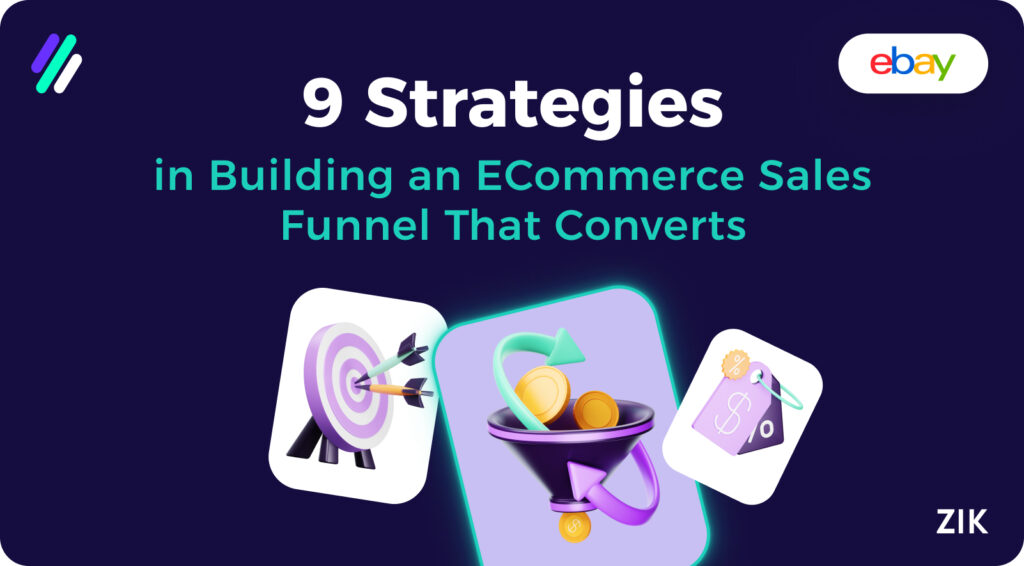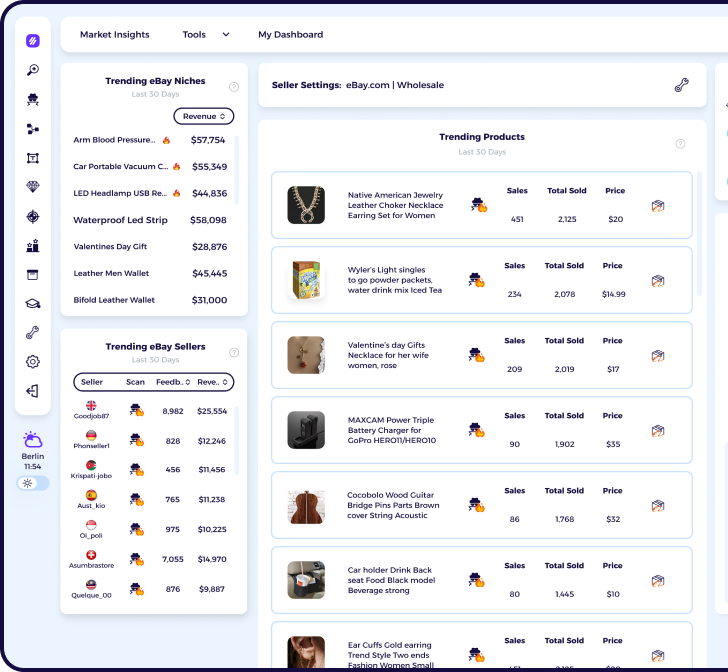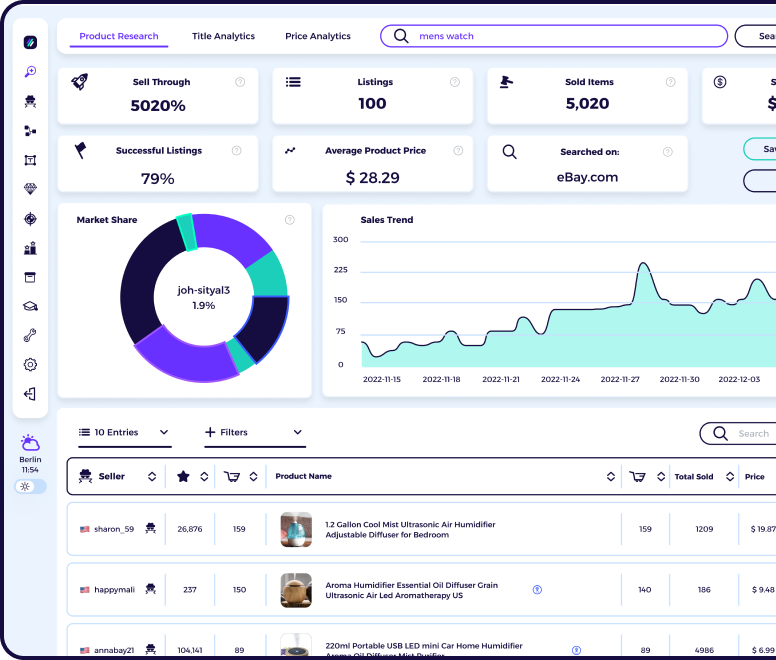You’ve created a brand, your online store is open, but the customers aren’t buying. What’s gone wrong?
Ecommerce is a massive industry brimming with success stories so it’s easy to think that setting up a digital shop is all you need to do. However, with an average conversion rate of between 2% and 4% (industry pending), it’s clear there is much more to eCommerce.

The secret to this? A well-structured sales funnel. When done well, a sales funnel can help take your customers on a journey from discovering your brand all the way to making a purchase. Want to know how, exactly? Keep reading.
What is an eCommerce sales funnel?
A sales funnel is the route you take a lead down to convert them into a paying customer. If you picture a funnel, it’s wider at the top, representing the large number of people who may visit your online store. As potential leads move through the funnel, it narrows, filtering out the people who don’t really align with your brand, and squeezing through the people who do.
In simpler terms, a sales funnel is a way of guiding customers through the sales process. But, the rate at which customers pass through the funnel can differ, with some taking moments and others taking months (or even years).
An effective sales funnel will have strategies for dealing with both types of customers.
Let’s now take a look at the five key stages of a sales funnel for eCommerce.
1. Awareness/attention phase
Customers in this phase are just discovering your brand and have probably found you through your online marketing such as AdWords, social media posts, or via an influencer. At this point, potential customers won’t have built up any trust in your brand and may even be wary of making a purchase. Your products could be poor quality or you could be running a scam.
Selling ‘trending’ products can really help you to create awareness of your brand. Certain tools are available to help you identify product niches or trending items that you could consider selling if they fit with your brand.
This is your opportunity to attract people to your brand, especially if you’re the new kid on the eCommerce block.
2. Interest/consideration phase
By this point, customers will have identified a need and your product may just be able to satisfy that need. With their curiosity piqued, this is a good time to engage people with testimonials and further information about your products. What might excite potential customers? A strong call to action may not work at this stage but if your goal is to get people to sign up for your newsletter then using good incentives may work.
You can work harder to build trust with localization, for example using a local domain name or area code. Businesses in the Oakland or East Bay area, for example, may use area code 501 so customers feel like they’re able to contact a local number if they have any problems.
3. Desire
During the desire phase, you should consider barriers to buying. What might be preventing people from making a purchase? It could be because you’re an unknown brand to them, in which case a strategy such as a ‘refer a friend’ offer or even influencer endorsements may help.
If you find that the price of your products is what’s causing potential customers to look elsewhere, highlight the quality and your USP.
4. Purchase/action phase
This is a self-explanatory step for the most part. At this stage, you can expect your prospects to make a purchase because you’ve done the necessary work to get them here. You can consider abandoned cart re-engagement strategies or exit pop-ups to help prompt anyone who doesn’t quite convert at this stage.
5. Aftercare and re-engagement phase
Post-purchase care plays an important role in customer retention. Solving problems, dealing with queries professionally and efficiently, and simply being available are all important parts of customer care.
But there are even more creative ways to help customers, and they don’t always involve having a call center. A software company, for example, may use remote support with RealVNC to help customers who are having difficulty using a program.
Once you have a happy customer, you’ll want to keep them. Why? Because they’ve already journeyed through your sales funnel and converted. Your job from here is to keep reminding them you exist by sharing exciting product news, special offers, and anything new happening within your business.
Strategies to build an eCommerce sales funnel that converts
First and foremost, you must know your audience. Who are they (age, gender, location etc)? What drives them? What are their interests? Your entire funnel should be based on your target audience.
Once you understand who your audience is and the general customer journey, it’s time to put the steps below in place.

1. Make sure your eCommerce site is user-friendly
To attract customers, you’ll need a site that’s easy on the eye with intuitive navigation. Start by mapping out your site, so it can also take your customer on a journey. For example, if a customer looks at something, is all the necessary information available such as materials used, how it works, sizing, etc?
Are similar items recommended nearby just in case the particular product the customer is looking at isn’t quite right? Are your shipping and returns policies easy to find and written in a clear way?
ECommerce localization is a good way to improve the user-friendly aspect of your site as people will feel like they’re dealing with a local business, even if you’re in another state or even country.
2. Leverage the Facebook lookalike strategy
When you’re creating awareness, you can utilize the Facebook lookalike strategy to identify and target people that the platform sees as your ideal customer. The feature can find shoppers with interests and traits similar to the profiles you’ve suggested. This means you can cast your net wide and catch a large but relevant audience.
3. Hunt for your competitor’s dissatisfied customers
Reviews are useful for customers making purchasing decisions, but they’re also great for sussing out what your competitors are doing wrong. They also give you a feel for the market, customer desires, and needs.
You can build ‘problems with other products’ into your branding. For example, if you make high-quality toilet rolls and a common complaint online is flimsy loo roll that rips, you can use that in your branding, by promoting ‘the strongest ever toilet paper’.
4. Promote UGC on your channels
Leverage the interest phase of the funnel by promoting user-generated content. Allow prospects to see ‘real’ people using the products and giving their own opinions. This can help build more trust in your brand as these endorsements come from outside sources.
5. Have a live chatbot
Whilst detailed FAQs can solve a lot of queries, a chatbot can address things that are a bit more complex, or help out customers who haven’t spotted the FAQs. Chatbots are a quick way of addressing queries before you lose a customer to another webpage.
Many queries will revolve around shipping, so it’s important to choose suppliers that can deliver on time and allow you to manage customer expectations.
6. Use pre-exit pop-ups
If you start to lose customers at the ‘desire’ phase, it might be because they have concerns or haven’t had enough prompts to make their purchase. Exit pop-ups such as ‘save cart to email’ or ‘buy now for 10% off’ can help to convert leads at this stage.
7. Offer a range of checkout and postage options
When customers reach the ‘action’ stage and they’re ready to make a purchasing decision, there are a few things that can still cause them to abandon their carts. One common reason is having to ‘sign up’ to make a purchase. A guest checkout option can help overcome this.
Another reason for people to quit at the last minute is high shipping costs, additional fees, and taxes. All costs should be clear and itemized. Misleading customers into thinking something is cheaper than it is can damage trust. Instead, note under all prices ‘shipping and taxes apply’ and make sure costs are clear on the purchase page to avoid uncertainty.
8. Communicate with customers after they make a purchase
As we’ve seen earlier, good aftercare is an essential part of the funnel. Having multiple ways of getting in touch through ways such as contact center services can help create a good customer relationship.
Emails are another effective tool to achieve this. By sending confirmation emails, you can put customers’ minds at ease as they know their orders have been received. Estimated delivery dates are also helpful, as are any product tips and reviews you could share.
Positive, informative communication can keep customers engaged with your brand and more likely to open future emails and make further purchases.
9. Continuously monitor and improve
Once you’ve established your sales funnel, there’s a good chance it will need refining over time. Just because something is working now, that might not necessarily mean it will keep on working. So, it’s important to leverage analytics to identify ‘leaks and fixes’ so you can increase your conversions even more.
Wrapping up
Understanding each step in the funnel is key to creating an eCommerce funnel that works for your business. Once you have created your sales funnel, you will have a clearer picture of your customer journey and have the knowledge to make the buying process as painless as possible.
Really, you’re providing all the relevant information and removing as many barriers to the purchase as you can. Remember, know your audience, attract potential leads, show them what they want to see and remove any hurdles. You can’t please everyone but if you know your audience you can please most of them!






